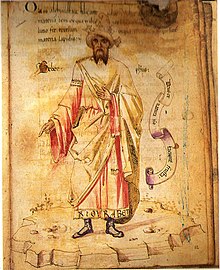Abu Musa Jabir bin Hayyan
Abu Musa Jabir ibn Hayyan (Arab: جابر بن حیان, Parsi: جابرحیان , acok disabuik jo nisbah al-al-Bariqi, al-Azdi, al-Kufi, al-Tusi atau al-Sufi; c. 721–c. 815),[4] juo disabuik Geber di Dunia Barat, adolah surang polymath (ahli dalam babagai bidang ilmu): ahli alkimia jo kimia, astronomi, insinyur, geografi, pilsapaik, fisik, dokter jo farmasi. Baliau lahia jo mandapek pandidikan di Tus, Iran, jo sudah tu bapindah ka Kufah (kini di Irak). Jabir dianggap sabagai apak ilmu kimia.[5][6][7]
| Jabir ibn Hayyan | |
|---|---|
 Potret "Geber" abaik ka-15, Codici Ashburnhamiani 1166, Biblioteca Medicea Laurenziana, Florence | |
| Gala | Abu Musa Jabir ibn Hayyan |
| Lahia | c. 721 M Tus, Kekhalifahan Umayyah[1] |
| Maningga | c. 815 AD |
| Etnis | Arab[2][3] atau Parsi |
| Era | Era Keemasan Islam |
| Agamo | Islam |
| Tumpuan utamo | Alkimia jo Kimia, Astronomi, Astrologi, Parubatan jo Kimia, Pilsapaik, Fisik |
| Karya tanamo Notable work(s) | Kitab al-Kimya, Kitab al-Sab'een, jo lain-lain. |
Dipangaruah dek
| |
Pangaruah
| |

Kasadonyo, disabuik Jabir maasiaan ampia 3 000 traktat jo artikel.[8] Skop karya laweh: kosmologi, musik, kasiatan, magi, biologi, teknologi kimia, geometri, nahu, metafisik, logika, regenerasi kaidupan sacaro otomatis, ramalan astrologi, jo mitos Imami.[9]
Baa, maikuik karajo perintis dek Paul Kraus, nan manunjuakan sabanyak babarapo ratuih karya nan dikato dibuek Jabir mungkin dibuek urang lain,[10][11] nan banyak dibuek di akia abaik ka-9 jo awal abaik ka-10, banyak urang sarjana picayo nan banyak dari karya-karya tu tadiri dari ulasan jo tambahan nan dibuek dek pangikuiknyo.[12]
Rujuakan
suntiang- ↑ Tus, V. Minorsky, The Encyclopaedia of Islam, Vol. X, ed. P.J. Bearman, T. Bianquis, C.E. Bosworth, E. van Donzel and W.P. Heinrichs, (Brill, 2000), 741.
- ↑ Kraus, P. (1962). "Djābir B. Ḥayyān". Encyclopaedia of Islam. 2 (edisi ke-2nd). Brill Academic Publishers. pp. 357–359. "As for Djābir's historic personality, Holmyard has suggested that his father was "a certain Azdī called Hayyan, druggist of Kufa... mentioned... in connection with the political machinations that were used by many people, in the eighth century, finally resulted in the overthrow of the Umayyad dynasty.".
- ↑ Holmyard, Eric John, "Introduction" to The Works of Geber, translated by Richard Russell (London: Dent, 1928), p. vii: "Abu Musa Jabir ibn Hayyan, generally known merely as Jabir, was the son of a druggist belonging to the famous South Arabian tribe of Al-Azd. Members of this tribe had settled at the town of Kufa, in Iraq, shortly after the Muhammadan conquest in the seventh century A.D., and it was in Kufa that Hayyan the druggist lived."
- ↑ "Abu Musa Jabir ibn Hayyan". Encyclopædia Britannica Online. Diakses tanggal 11 February 2008.
- ↑ Derewenda, Zygmunt S. (2007), "On wine, chirality and crystallography", Acta Crystallographica A, 64: 246–258 [247], doi:10.1107/s0108767307054293
- ↑ John Warren (2005). "War and the Cultural Heritage of Iraq: a sadly mismanaged affair", Third World Quarterly, Volume 26, Issue 4 & 5, p. 815-830.
- ↑ Dr. A. Zahoor (1997). JABIR IBN HAIYAN (Geber) Archived 2008-06-30 di Wayback Machine.. University of Indonesia.
- ↑ Josef W. Meri, Jere L. Bacharach (2006). Medieval Islamic Civilization. Taylor and Francis. p. 25. ISBN 0-415-96691-4
- ↑ Haq, Syed Nomanul (28 February 1995). Names, Natures and Things: The Alchemist Jabir Ibn Hayyan and His Kitab Al-Ahjar (Book of Stones). Springer. p. 5. ISBN 978-0-7923-3254-1. https://books.google.com/?id=P-70YjP0nj8C. Diakses pado 18 Juni 2010.
- ↑ Haq, Syed Nomanul (28 February 1995). Names, Natures and Things: The Alchemist Jabir Ibn Hayyan and His Kitab Al-Ahjar (Book of Stones). Springer. p. 3. ISBN 978-0-7923-3254-1. https://books.google.com/?id=P-70YjP0nj8C. Diakses pado 18 Juni 2010.
- ↑ Jabir Ibn Hayyan. Vol. 1. Le corpus des ecrits jabiriens. George Olms Verlag, 1989
- ↑ Paul Kraus, Jabir ibn Hayyan: Contribution à l'histoire des idées scientifiques dans l'Islam, cited Robert Irwin, 'The long siesta' in Times Literary Supllement, 25/1/2008 p.8